Palladium-catalyzed allylic etherification of phenols with vinyl ethylene carbonate
- PMID: 35936101
- PMCID: PMC9354801
- DOI: 10.3389/fchem.2022.962355
Palladium-catalyzed allylic etherification of phenols with vinyl ethylene carbonate
Abstract
The palladium-catalyzed decarboxylative reactions of phenols and vinyl ethylene carbonate to produce allylic aryl ethers under mild conditions have been established. Adopting an inexpensive PdCl2(dppf) catalyst promotes the efficient conversion of phenols to the corresponding allylic aryl ethers via the formation of a new C-O bond in good isolated yields with complete regioselectivities, acceptable functional group tolerance and operational simplicity. The robust procedure could be completed smoothly by conducting a scaled-up reaction with comparable efficiency to afford the target product.
Keywords: C-O bond formation; allylic etherification; palladium-catalyzed; phenols; vinyl ethylene carbonate.
Copyright © 2022 Lin, Zhao, He, Li, Jiang, Xiang, Ye and Gan.
Conflict of interest statement
The authors declare that the research was conducted in the absence of any commercial or financial relationships that could be construed as a potential conflict of interest.
Figures




Similar articles
-
Benzyl protection of phenols under neutral conditions: palladium-catalyzed benzylations of phenols.Org Lett. 2008 May 15;10(10):1979-82. doi: 10.1021/ol800548t. Epub 2008 Apr 11. Org Lett. 2008. PMID: 18402462
-
Synthesis of Polyfluorinated Biaryls via Palladium-Catalyzed Decarboxylative Cross-Coupling of Zinc Polyfluorobenzoates with Aryl Fluorosulfates.J Org Chem. 2025 Apr 25;90(16):5480-5486. doi: 10.1021/acs.joc.5c00099. Epub 2025 Apr 11. J Org Chem. 2025. PMID: 40217569
-
Selective synthesis of allylated oxime ethers and nitrones based on palladium-catalyzed allylic substitution of oximes.J Org Chem. 2005 Jul 8;70(14):5630-5. doi: 10.1021/jo050632+. J Org Chem. 2005. PMID: 15989347
-
Ir(I)-catalyzed enantioselective decarboxylative allylic etherification: a general method for the asymmetric synthesis of aryl allyl ethers.Org Lett. 2013 Feb 1;15(3):512-5. doi: 10.1021/ol3033237. Epub 2013 Jan 14. Org Lett. 2013. PMID: 23317334
-
Enantioselective Construction of Tertiary C-O Bond via Allylic Substitution of Vinylethylene Carbonates with Water and Alcohols.J Am Chem Soc. 2017 Aug 9;139(31):10733-10741. doi: 10.1021/jacs.7b04759. Epub 2017 Aug 1. J Am Chem Soc. 2017. PMID: 28727424
References
-
- Consiglio G., Waymouth R. M. (1989). Enantioselective homogeneous catalysis involving transition-metal-allyl intermediates. Chem. Rev. 89, 257–276. 10.1021/cr00091a007 - DOI
LinkOut - more resources
Full Text Sources

